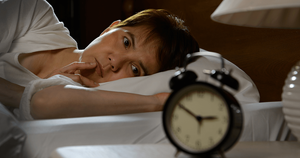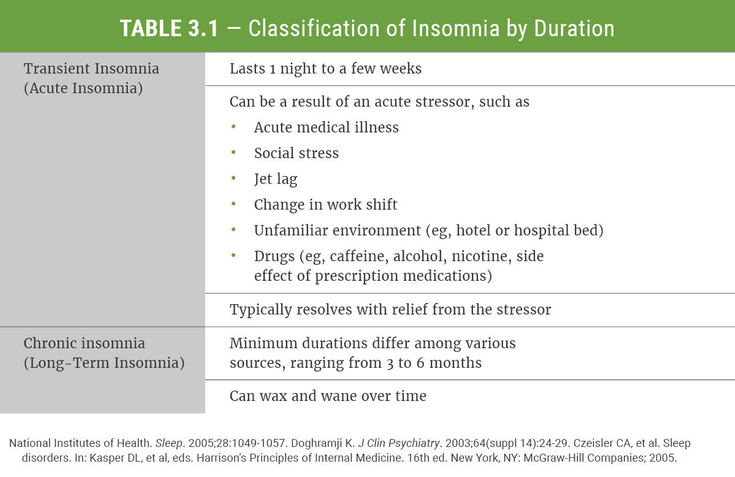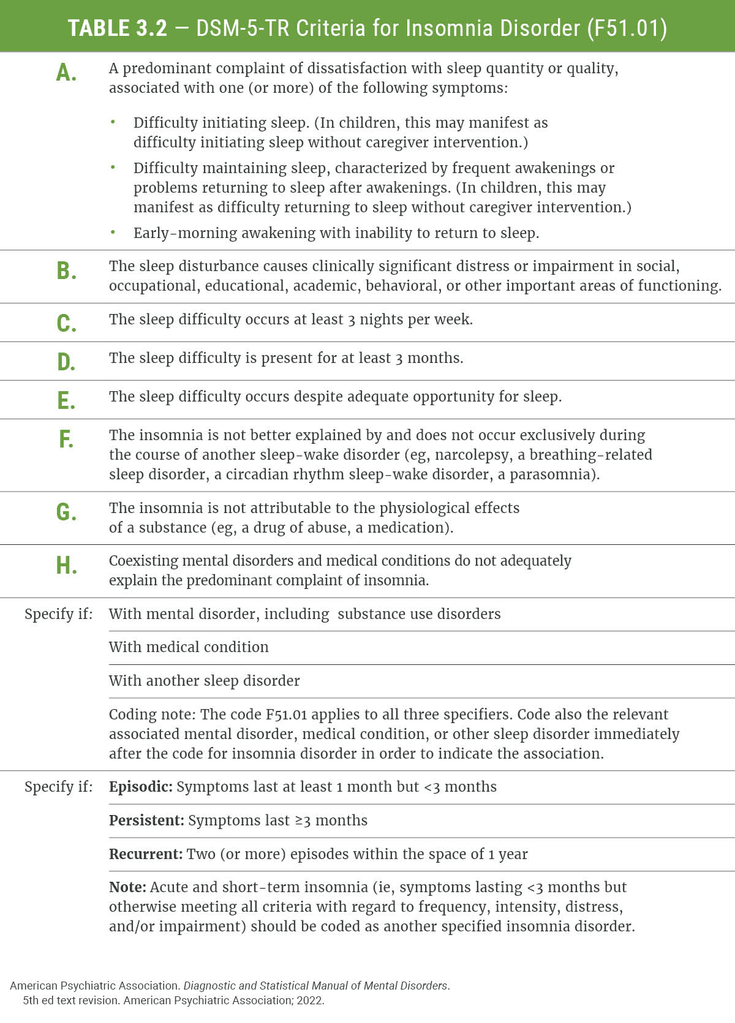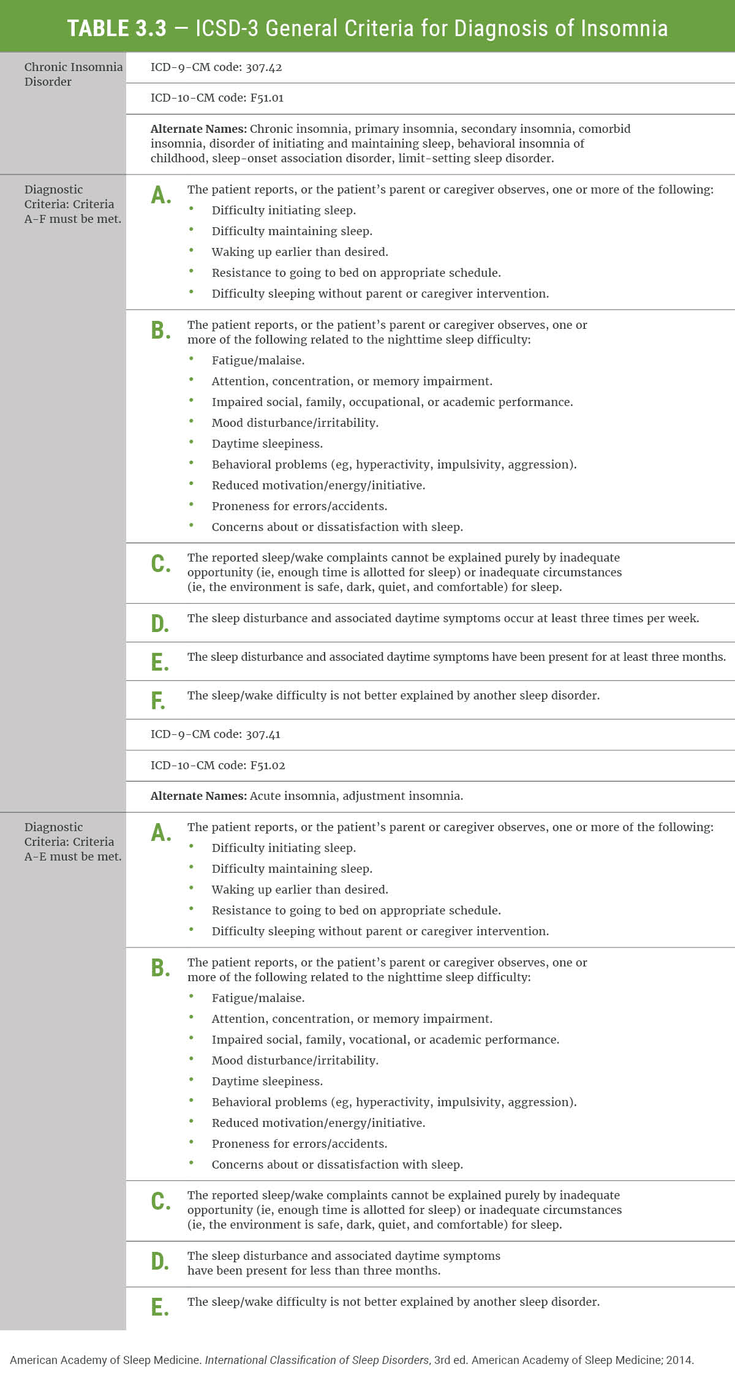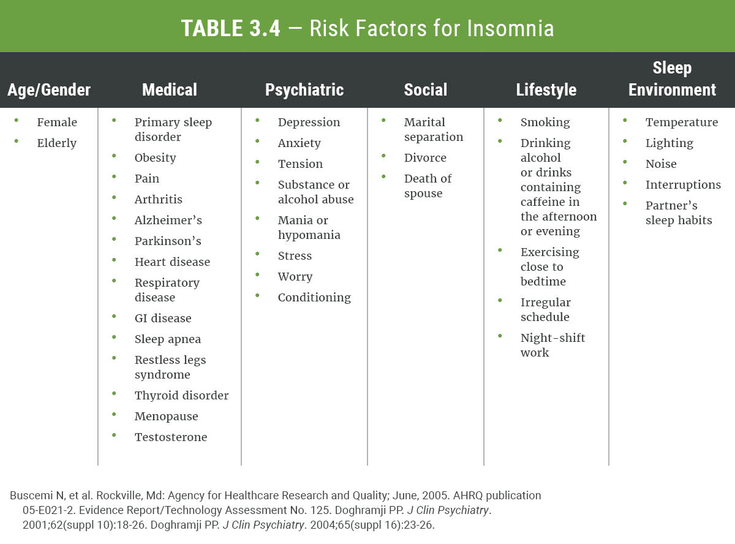Definitions, Nosology & Demographics
Definition
Insomnia is a complaint of dissatisfaction with sleep quantity, quality, or both. It is the second most commonly expressed symptom (after pain) in primary care. It is defined as a (repeated) difficulty with sleep initiation (getting to sleep), duration (waking up too early), consolidation (staying asleep), or quality (feeling refreshed). These generally parallel patients’ subjective complaints of:
- Difficulty with prolonged sleep latency (difficulty falling asleep)
- Multiple awakenings in the early, middle, or late portions of the night
- Waking up for the day too early.
These sleep difficulties occur despite adequate time and opportunity for sleep. Many diagnostic systems also stipulate, therefore, that the complaint must be associated with daytime impairment for it to meet diagnostic criteria for insomnia.
Patients suffering from insomnia typically have a mixture of these patterns, with most patients experiencing, on average, two of these symptoms. That is, it is quite…
To continue reading
Log in or register to continue reading. It's free!
OR
By signing up to create an account, I accept Healio's Terms of Use and Privacy Policy.
Definition
Insomnia is a complaint of dissatisfaction with sleep quantity, quality, or both. It is the second most commonly expressed symptom (after pain) in primary care. It is defined as a (repeated) difficulty with sleep initiation (getting to sleep), duration (waking up too early), consolidation (staying asleep), or quality (feeling refreshed). These generally parallel patients’ subjective complaints of:
- Difficulty with prolonged sleep latency (difficulty falling asleep)
- Multiple awakenings in the early, middle, or late portions of the night
- Waking up for the day too early.
These sleep difficulties occur despite adequate time and opportunity for sleep. Many diagnostic systems also stipulate, therefore, that the complaint must be associated with daytime impairment for it to meet diagnostic criteria for insomnia.
Patients suffering from insomnia typically have a mixture of these patterns, with most patients experiencing, on average, two of these symptoms. That is, it is quite common for patients who have difficulty falling asleep to also have nocturnal awakenings with difficulty returning to sleep. The insomnia symptom most commonly seen is waking up feeling drowsy or tired; close to 75% of all patients with insomnia report this symptom. Two thirds of these patients wake up in middle of the night, with more than half having trouble falling back to sleep after a middle-of-the-night awakening. Nearly the same number have trouble falling to sleep when they go to bed and, finally, a bit less than half wake up for the day too early.
These patterns of the insomnia complaint can change over time—difficulty staying asleep can shift to trouble falling asleep. In one study, symptoms changed in 50% of patients over a 4-month period. Therefore, physicians must have regular follow-up with their patients with insomnia to take into account the ever-shifting nature of insomnia when considering treatment options.
Polysomnographic recordings typically reflect some degree of sleep disturbance. Figure 3-1 shows the various polysomnographic patterns produced by insomnia. Subjective polysomnographic reports provided by patients on the severity of their insomnia are generally over-estimates. Patients suffering from an unusual form of insomnia referred to as “paradoxical insomnia” in the ICSD-3 often complain of protracted periods of sleeplessness despite a relatively normal PSG pattern.
Many patients with insomnia are also afflicted with brief PSG arousals, sleep-stage transitions to a lighter stage of sleep or to wakefulness, which last <15 seconds. These typically go unnoticed by the sleeper, yet may lead to the sensation of unrestful sleep after a full night’s slumber.

Diagnostic Terms and Categorization
Traditionally, the pattern of insomnia has been divided into subtypes based on a variety of clinical parameters, including frequency of occurrence over time (weeks or months), symptom duration (acute or chronic) and nightly sleep pattern (disrupted or continuous). Although these variables have been of some use from a clinical standpoint, their validity in isolation from a diagnostic standpoint has not been established.
Traditionally, categorization of insomnia according to duration (Table 3-1) has been connected with etiologic and management implications, suggesting that acute and transient insomnias are more typically due to adjustment issues that resolve with conservative treatment approaches, whereas chronic insomnias are due to more resilient difficulties that require greater investigative effort in order to arrive at the proper diagnosis and treatment. Regrettably, these assumptions have never been substantiated; therefore, this type of categorization may have limited practical value.
The growing understanding of insomnia as a disorder has prompted significant changes in how it is defined diagnostically over the past few decades. Until recently, classification systems defined insomnia mostly as a symptom of other disorders. Insomnia was labeled as primary when it was presumed to be unrelated to a comorbid condition or in the absence of comorbidities. Conversely, insomnia was labeled as secondary (comorbid) when it was found in the context of another disorder and, therefore, presumed to arise from that disorder.
Despite these classifications, it is now acknowledged that when insomnia and another major medical or psychiatric disorder coexist, the nature of the connection between the two entities is largely not understood. That is, insomnia may be caused by the underlying disorder, may be an independent entity, or may conceivably cause the co-morbid disorder itself. Although the identification of the underlying cause is an important clinical endeavor, current thinking leans towards addressing the insomnia as an independent clinical condition before, during and/or after identifying and treating the comorbidity. This line of thinking is reflected in recent updated versions of many insomnia classification systems. The three main diagnostic manuals produced by different organizations vary in their approach to defining insomnia, based on utility and type of audience.
DSM-5
The Diagnostic and Statistical Manual of Mental Disorders criteria developed by the American Psychiatric Association are likely the ones most commonly utilized in research studies of insomnia and are utilized clinically primarily by psychiatrists and general health care practitioners. The most recent updated DSM version, the 5th edition text revision (DSM-5-TR), offers a small number of broad categories based on current symptoms and functioning involved in sleep disorders (Table 3-2).
The most prominent change in the DSM-5 from the earlier DSM IV TR was the changing of disease terminology to “insomnia disorder.” This switch was made to avoid the differentiation of primary and secondary (comorbid) insomnia when this disorder occurs with other conditions, and is retained in the DSM-5-TR. Undertreatment from the dismissal of “secondary” insomnia may also be avoided with this term. The DSM-5 introduced a greater emphasis on the bidirectional and interactive nature of the complex relationship between sleep disorders and concurrent mental or medical conditions. Therefore, the two previous diagnoses—sleep disorder related to another mental disorder and sleep disorder related to another medical condition—were eliminated. In addition, greater specification of coexisting conditions is provided for each sleep-wake disorder, referred to as comorbidities.
Other changes include the alteration of the chief complaint from “insomnia” to “dissatisfaction with sleep quantity or quality,” addition of “early morning awakening” criterion, change in the minimum duration of the complaint from 1 to 3 months, addition of a frequency criterion of >3 nights per week, and addition of qualifiers for comorbid conditions. Throughout the DSM-5 classification of sleep-wake disorders, pediatric and developmental criteria and text are integrated where appropriate, encompassing age-dependent variations in clinical presentation.
ISCD-3
The International Classification of Sleep Disorders manual developed by the American Academy of Sleep Medicine (AASM) is divided into six descriptive, etiologic categories (Table 3-3). This system is primarily used by sleep medicine clinicians and researchers for the diagnosis and treatment of sleep disorders. The 3rd edition (ISCD-3), introduced in 2014, re-defines insomnia so that criteria are largely consistent with those utilized by the DSM-5.
Research has provided very limited support for the reliability and validity of the various specific subtypes discussed in ICSD-2. In the ICSD-3, previously defined insomnia subtypes from the ICSD-2, including psychophysiologic, idiopathic, and paradoxical insomnia, behavioral insomnia of childhood, insomnia due to another (mental) disorder, insomnia due to a medical condition and insomnia due to a drug or substance, have been subsumed under the term “chronic insomnia disorder” (Table 3.3). This is a result of the observation that many of the defining features of the so-called primary insomnia subtypes such as conditioned arousal, poor sleep hygiene practices and underestimation of sleep time, are ubiquitous among patients with insomnia and are not specific to one subgroup. As a result, discrimination among these various subtypes in clinical practice has proven difficult.
ICD-11
The International Classification of Diseases, 11th revision (ICD-11), published by the World Health Organization, is commonly used for statistical purposes, especially in European and Asian countries. The ICD-11 follows ISCD-3 in classifying insomnia as either chronic or short-term. It defines chronic insomnia as “a frequent and persistent difficulty initiating or maintaining sleep that occurs despite adequate opportunity and circumstances for sleep and that results in general sleep dissatisfaction and some form of daytime impairment.” The ICD-11 specifies that in cases where insomnia is caused by another condition, chronic insomnia should be diagnosed only if it is “an independent locus of clinical attention.”
Demographics
Studies on the prevalence of insomnia in adults have yielded variable results, largely owing to variations in defining insomnia. Estimates of insomnia prevalence have varied widely, from 5% to 50%. This variability was illustrated by the findings of one study, which estimated the prevalence of insomnia according to four different definitions (insomnia symptoms, insomnia symptoms with daytime consequences, sleep dissatisfaction and insomnia diagnoses). While about one third of the measured population presented at least one DSM-IV insomnia criterion, when daytime consequences of insomnia were taken into account, the prevalence was 9% to 15%. Eight percent to 18% of the population reported dissatisfaction with sleep, while insomnia occurred in approximately 6% of the population when using the diagnostic classification from the DSM-IV (Figure 3-2).
Despite these variations, it is clear that insomnia is a common malady; over half of American adults report having trouble with sleep a few nights per week or more. The NIH State-of-the-Science Conference Statement noted that 30% of the general population has complaints of sleep disruption and 10% has associated symptoms of daytime functional impairment consistent with the diagnosis of insomnia (Figure 3-3). In the 2020 National Health Interview Study (NHIS), 14.5% of adults in the United States had trouble falling asleep most days or every day in the past 30 days (Figure 3-4). These data also showed a significant age-related trend (less difficulty falling asleep with increasing age) as well as differences associated with sex (more women than men had difficulty falling asleep) and race/ethnicity (fewer non-Hispanic [NH] Asian adults had difficulty falling sleep than NH White, NH Black, or Hispanic adults). The same NHIS survey also revealed that 17.8% of adults in the US had trouble staying asleep most days or every day in the past 30 days (Figure 3-5). A significantly smaller proportion of adults 18-44 years of age had trouble staying asleep compared to those in older categories. There were also significant differences among the sexes (more women than men reporting difficulty staying asleep) and races/ethnicities (more NH Black than Hispanic or NH Asian adults and more NH White adults than any other ethnicity reporting difficulty staying asleep).
The prevalence of insomnia in primary care settings appears to be even higher—patients with insomnia typically do not feel as well as good sleepers and often have associated comorbidities. Two studies have shown that >50% of patients who come into a primary care physician’s office suffer from a sleep problem. Another primary care study noted that the prevalence of insomnia was 69%, with 50% reporting occasional insomnia and 19% reporting chronic insomnia (Figure 3-6). As expected, patients with chronic insomnia had the most severe sleep complaints as well as the poorest daytime functioning and exhibited the most help-seeking behaviors. Interestingly, most patients with insomnia did not spontaneously discuss the complaint with their physicians. The four factors that predicted that patients would enter such a discussion were identified; these included the following:
- Feeling worse physically
- Being afflicted by insomnia for a longer period of time
- Older age
- Higher income.
On the other hand, those who did not bother to discuss insomnia with their physicians were younger adults without concomitant health problems who had sleep problems for a shorter period of time.
Also quite revealing in this study was the observation that only a fraction (about one third) of patients with insomnia mentioned the symptom to their physicians. In a second study, about 50% of primary care patients were found to have insomnia (Figure 3-7). But again, only about one third reported the problem spontaneously and only 5% actually sought treatment. The reasons for why patients do not seek medical attention from their primary care providers for insomnia are not clear but may be due to patients’ misconceptions that sleep problems are not worthy of discussion or investigation. Cultural differences also exist with this type of avoidance of medical care, with some ethnicities less likely to bring up sleep problems to their PCPs. These data highlight the importance of actively inquiring about insomnia in clinical settings, especially when patients present with comorbidities that commonly occur with sleep disturbances.
In a cohort study of 3,073 patients followed up yearly for a period of 5 years, 13.9% of good sleepers at baseline developed insomnia during follow-up, and incidence was higher in women (17.6%) than men (10.1%)(P = 0.03). Among patients with insomnia at baseline, the condition persisted in each annual check-up throughout the follow-up period, underscoring the need for early identification and treatment.






Populations at Risk for Insomnia
Risk factors for insomnia (Table 3-4) include gender, age, depression and other psychiatric illnesses, snoring, inactivity, comorbid medical conditions, nocturnal urination, regular hypnotic use, onset of menstruation, menopause, history of sleep disturbance and stress. Certain population groups are at higher risk for insomnia, such as women, the elderly and those with irregular sleep habits, such as night-shift workers.
Women
Women are at greater risk for developing insomnia. In one study, women were more than one and a half times more likely to have insomnia than men. Further, the prevalence of insomnia rises by a magnitude of approximately 40% during perimenopause and menopause.
Hormonal changes during the various phases of a woman’s life (e.g., menstruation, pregnancy and menopause) likely contribute to disturbed sleep. The effect of hot flashes commonly seen in menopause is controversial. One study reported an association between hot flashes and awakenings from sleep. However, another found no relationship between hot flashes and objective sleep measures of sleep quality. Nevertheless, hot flashes appear to be associated with poor subjective sleep quality.
Sleep disorders seem to occur more commonly during menopause. The prevalence of sleep disordered breathing is higher in postmenopausal women and data showed that menopause was an independent risk factor for sleep apnea syndrome. Psychiatric problems occur more frequently during menopause and, as clarified earlier, these conditions are more likely to be associated with insomnia. Insomnia is also more common in adolescent girls (ages 11 to 14) than in younger girls (30.4% vs 16.8%), and its prevalence peaks during pregnancy and in the years during menopause.
Elderly Individuals
Symptoms of insomnia occur in 30-48% of elderly individuals, with the prevalence of insomnia disorder itself ranging from 12% to 20%. This may, in part, be due to the natural fragmentation of sleep that accompanies aging (Figure 3-8). Moreover, older adults are more likely to take naps, suggesting that age-dependent changes reflect a reduced ability, rather than need, to achieve sleep. Increased prevalence of sleep problems in elderly individuals may also be due to general increases in infirmity, inactivity, dissatisfaction with social life and poor sleep habits. Inappropriate treatment initiated by the patient, family members, physicians, or other care providers may perpetuate the problem. Finally, recalcitrant insomnia that occurs in dementia is a common cause for institutionalizing the elderly. The most common sleep disturbance is sleep discontinuity, where awakenings are noted during the sleep period. However, while rates of insomnia generally increase with age, rates of sleep dissatisfaction and diagnoses show little variation.

Other Risk Factors
Other risk factors for insomnia include irregular sleep/wake patterns, as seen in shift workers, whose prevalence is increasingly growing in our now 24/7 society. Studies have shown that 15% of full-time wage and salary workers work an alternative shift (night, evening, rotating, or on-call shifts). Studies show that 25% of shift workers have insomnia severe enough to meet the diagnosis of shift-work sleep disorder (SWSD). Additional risk factors include less education, unemployment, separation or divorce, poor mental and physical health and medical illness.
Summary
In summary, insomnia is a complaint of dissatisfaction with sleep quantity, quality, or both, characterized by difficulty achieving and maintaining sleep, as well as achieving restful sleep despite adequate time and opportunity. Although insomnia has been classically associated with other comorbid disorders, recent paradigm shifts have recognized the importance of addressing insomnia as an independent clinical condition. This is reflected in current insomnia classification systems. However, patients may also not recognize the importance of insomnia as a distinct medical condition, and many neglect to mention their sleep problems to their care providers, contributing to vague estimates of insomnia prevalence. Future measures of insomnia are moving towards more concrete definitions.
References
- Doghramji K, Doghramji PP. Clinical Management of Insomnia, 3rd ed. Professional Communications Inc. 2023.
- Adjaye-Gbewonyo D, Ng AE, Black LI. Sleep difficulties in adults: United States, 2020. NCHS Data Brief. 2022;436:1-7.

